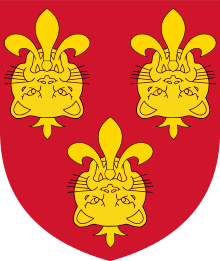Diocese of Hereford
| Diocese of Hereford | |
|---|---|
 Arms of the See of Hereford: Gules, three leopard's faces reversed jessant-de-lys or. These are the arms of Bishop Thomas de Cantilupe (d.1282) | |
| Location | |
| Ecclesiastical province | Canterbury |
| Archdeaconries | Hereford, Ludlow |
| Statistics | |
| Parishes | 347 |
| Churches | 409[1] |
| Information | |
| Cathedral | Hereford Cathedral |
| Current leadership | |
| Bishop | Richard Frith, Bishop of Hereford |
| Suffragan | Alistair Magowan, Bishop of Ludlow |
| Archdeacons |
Alistair Magowan, Bishop-Archdeacon of Ludlow Paddy Benson, Archdeacon of Hereford |
| Website | |
| hereford.anglican.org | |
The Diocese of Hereford is a Church of England diocese based in Hereford, covering Herefordshire, southern Shropshire and a few parishes within Worcestershire in England, and a few parishes within Powys and Monmouthshire in Wales. The cathedral is Hereford Cathedral and the bishop is the Bishop of Hereford. The diocese is one of the oldest in England (created in 676 and based on the minor sub-kingdom of the Magonsæte) and is part of the Province of Canterbury.
On 16 July 2014, it was announced that Richard Frith, Bishop suffragan of Hull, was to become the next Bishop of Hereford;[2] his canonical election was confirmed on 17 October 2014 and he was installed on 22 November in Hereford Cathedral.[3]
Bishops
The diocesan Bishop of Hereford (Richard Frith) is assisted by the Bishop suffragan of Ludlow, Alistair Magowan (whose see was created in 1981.) The provincial episcopal visitor (for parishes in this diocese – among twelve others in the western part of the Province of Canterbury – who reject the ministry of priests who are women, since 1994) is Jonathan Goodall, Bishop suffragan of Ebbsfleet, who is licensed as an honorary assistant bishop of the diocese in order to facilitate his work there.
A retired bishop, Michael Westall (Bishop of South West Tanganyika) lives in Kingstone, Herefordshire.[4]
Statistics
As reported in the Church of England's Statistics for Mission 2014, published in January 2016, the diocese had a population of 322,000, fewer than any other except Sodor and Man.[1] With 409 churches, the population per church was 790, the lowest of any diocese and less than 60% of the 1380 in the next lowest, St Edmundsbury and Ipswich.[1] Average weekly church attendance was 9,600, down from 10,000 in 2013.[5] The total worshipping community was estimated at 11,500, down from 11,800 in 2013, and 43% of these were aged over 70 years.[6]
References
- 1 2 3 "Statistics for Mission 2014 Table 1: Diocesan summary statistics, 2014" (PDF). Church of England. January 2016. Retrieved 2016-02-23.
- ↑ "New Bishop named for Diocese of Hereford". The Diocese of Hereford. 16 July 2014. Retrieved 21 August 2016.
- ↑ "Richard Frith becomes 105th Bishop of Hereford". The Diocese of Hereford. November 2014. Retrieved 21 August 2016.
- ↑ "Michael Robert Westall". Crockford's Clerical Directory (online ed.). Church House Publishing. Retrieved 18 June 2016. (subscription required)
- ↑ "Statistics for Mission 2014 Table 2: Diocesan average all age weekly attendance, all age Sunday attendance, and all age school service attendance, 2009 - 2014" (PDF). Church of England. Retrieved 2016-02-23.
- ↑ "Statistics for Mission 2014 Table 6: Diocesan worshipping community, 2012 - 2014" (PDF). Church of England. Retrieved 2016-02-23.
Sources
- Haydn's Book of Dignities (1894) Joseph Haydn/Horace Ockerby, reprinted 1969
- Whitaker's Almanack 1883 to 2004, Joseph Whitaker and Sons Ltd/A&C Black, London
- Church of England Statistics 2002
External links
Coordinates: 52°03′15″N 2°42′58″W / 52.0542°N 2.7160°W